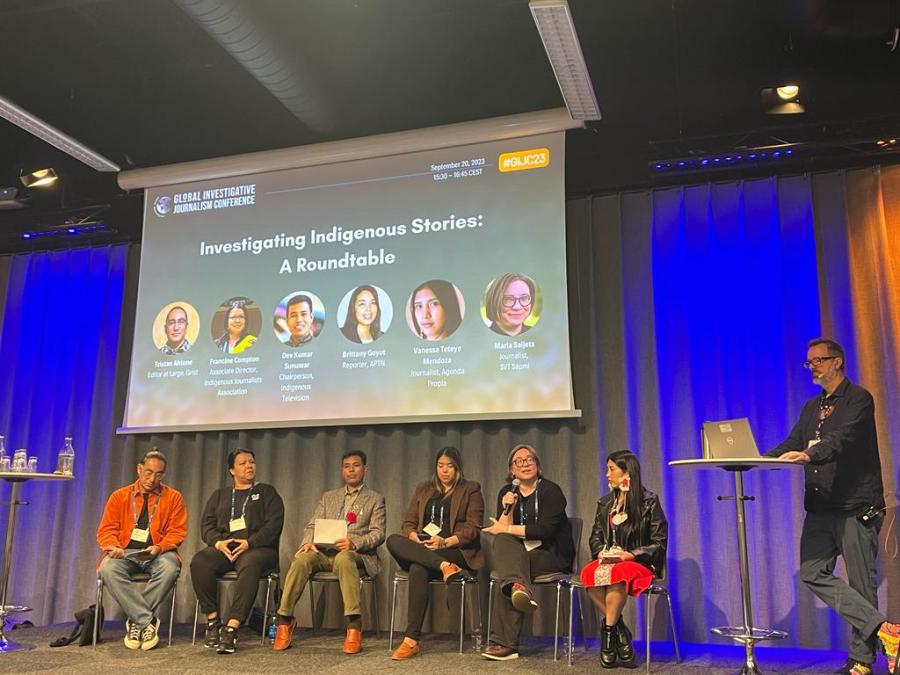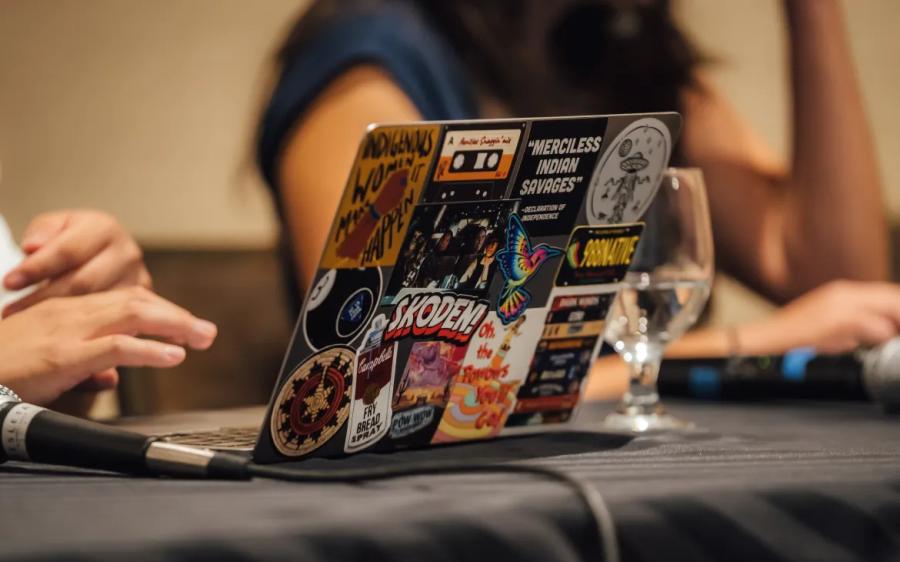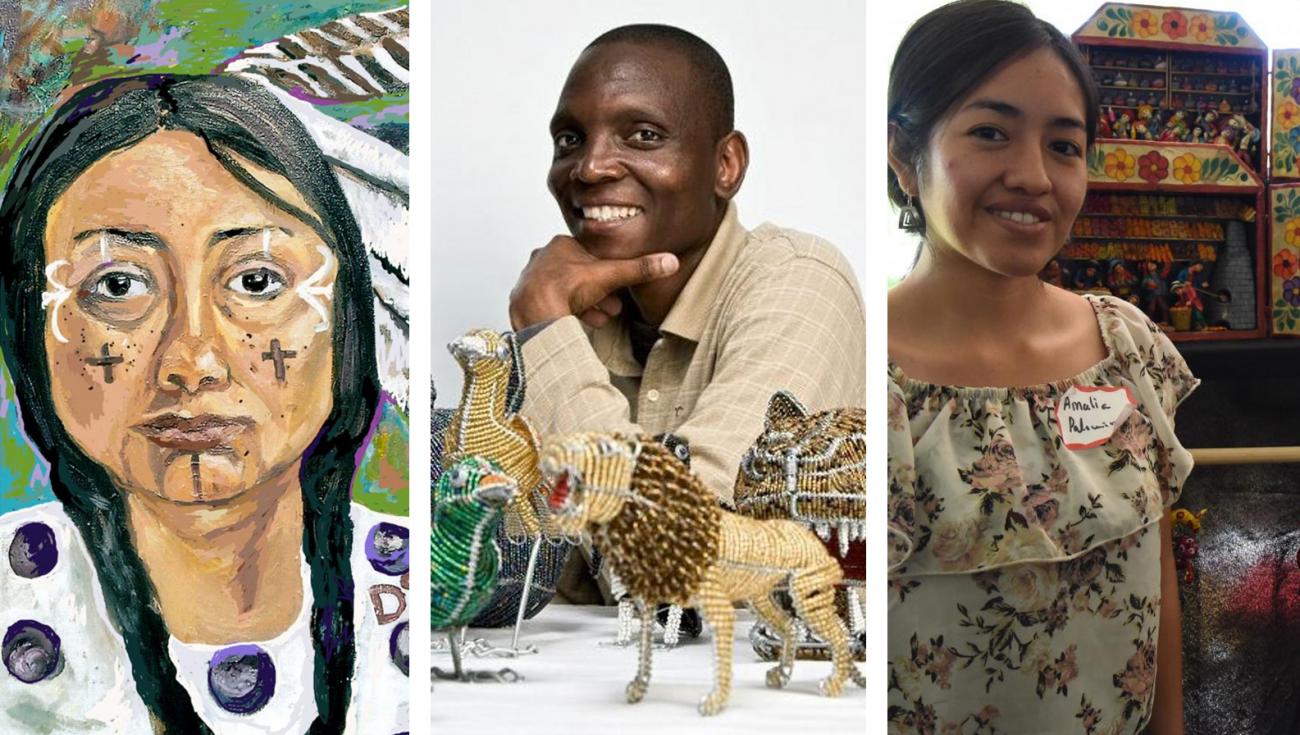
The COVID-19 pandemic has severely impacted many Indigenous communities and Indigenous artists have been especially affected due to lack of access to markets and barriers to travel to sell their work. The Cultural Survival Bazaars were canceled for four seasons, leaving many artists to experience extreme financial hardship. Thanks to the generous support of the John D. and Catherine T. MacArthur Foundation’s Equitable Recovery initiative, centered on advancing racial and ethnic justice, Cultural Survival is able to alleviate some of the burdens posed by the pandemic through grants to our longtime Bazaar artists. Cultural Survival sees the Bazaars as a creative solution to supporting Indigenous Peoples’ economic sovereignty and their rights to culture and freedom of expression. We supported 40+ artists with 23 grants from the Bazaar Program’s COVID-19 Relief Artist Support Fund totaling $59,500.
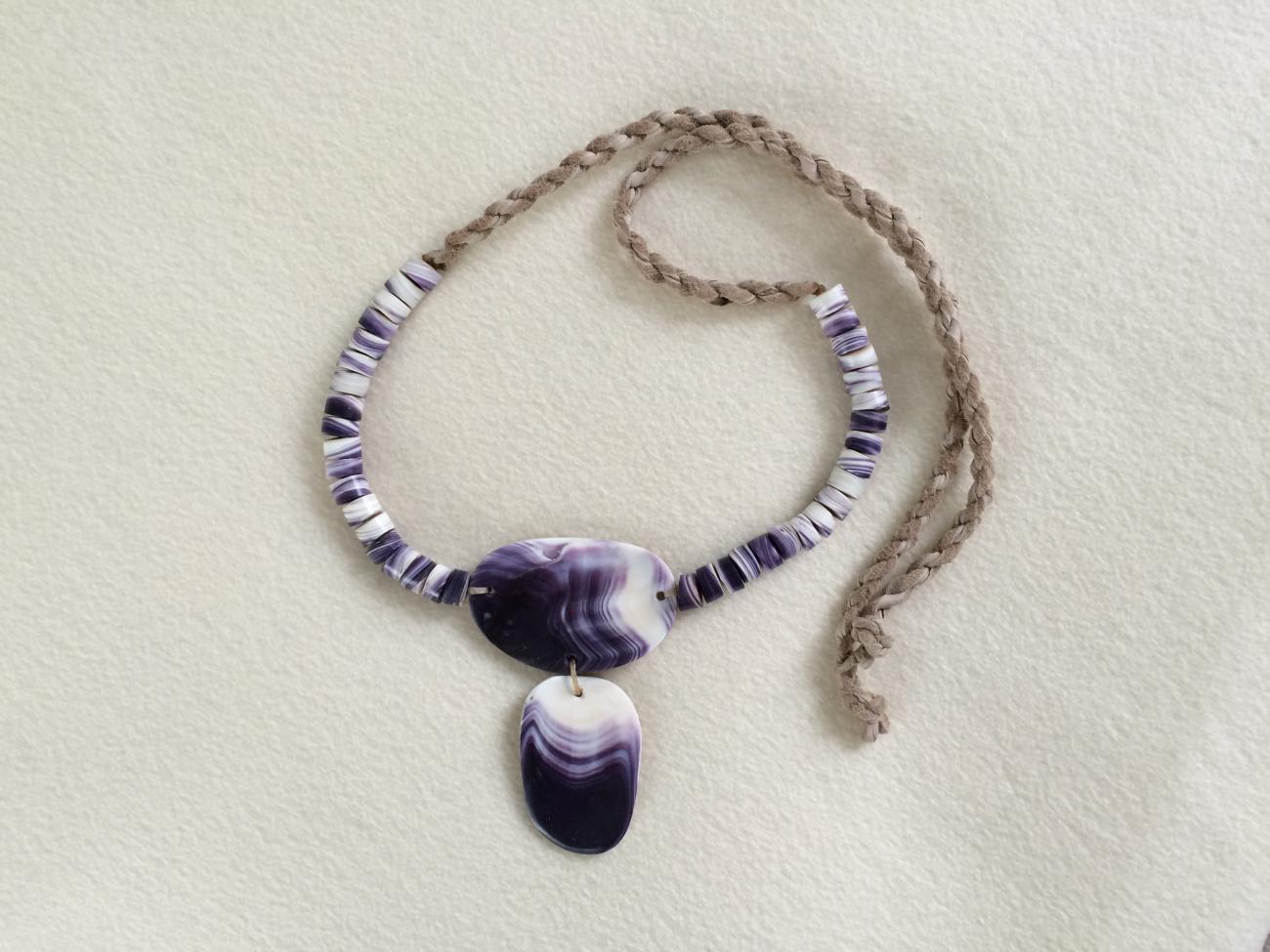
Wampum art by Elizabeth James-Perry.
United States
Elizabeth James-Perry (Aquinnah Wampanoag), Original Wampum Art, from Noepe (Martha’s Vineyard, MA). As a teenager, Elizabeth learned weaving, spinning, and beadwork from her cousins before learning to work with wampum made from local shells. She places particular emphasis on hand-made art pieces and gathers her own natural materials for her art. Artist website.
Deborah Spears Moorehead (Seaconke, Pokanoket, Wampanoag, Narragansett, Pequot, Mohawk, and Nipmuc), Painted Arrow Studio, from Massachusetts and Rhode Island. Deborah grew up with a passion for art, eventually discovering her love for oil painting in middle school. Her work focuses on documenting and amplifying the legacy of the Eastern Woodland Native American community.
Hawk Henries (Nipmuc), from Sullivan, ME. Hawk is a Native flautist who crafts his own flutes, each one made from a single piece of wood using hand tools and fire. He first discovered flute making after ruining and remaking a flute his family had given him. Artist website.
Sierra Henries (Nipmuc), from Sullivan, ME. Sierra began wood burning at the age of fifteen, working with different kinds of wood and gourd before eventually choosing birch wood. Her works include pins, hand mirrors, and jewelry, and she collects her own birch bark. Artist website.
Jannette Vanderhoop (Aquinnah Wampanoag), from Martha’s Vineyard, MA. Jannette creates jewelry self-described as “decidedly contemporary” in order to combat stereotypes of Native peoples. Her work uses local wampum shells as well as natural materials both found and reconstituted. Artist website
Rosanne Menard (Mi’kmaq, Maliseet, Blackfoot), Four Winds One Breath, from Massachusetts. Rosanne’s work includes jewelry, paintings, sculpture, clothing, and more. She first founded Four Winds Gallery in Bristol, Rhode Island in 2006. Artist website.
Barbara Gregg (Seneca) and Barry Lee (Munsee), from Mid-Atlantic United States. The music of Spirit Wing rings loud with Barbara Gregg and Andrews-Christy on vocals, flutes, and percussion and Barry Lee on vocals and guitar. Their music comes from the folk/acoustic tradition intertwined with traditional Native songs that date back hundreds of years.
Artist website
Jonathan Perry (Aquinnah Wampanoag) and Leah Hopkins Perry (Narragansett) from Martha’s Vineyard, MA. Jonathan is a speaker, singer, artist, and actor whose work involves educating the public about Wampanoag history and culture and lecturing on Eastern Woodland art and traditions. He is also a member of the Wampanoag Nation Singers and Dancers and a founding member of the Kingfisher Dance Troupe and the Iron River Singers. Artist website. Leah is a cultural ambassador, a skilled seamstress, beadwork artist, and an acclaimed Eastern Woodlands singer and dancer. She also provides cultural consultation and educational program development for her community and Eastern Woodlands Peoples.
Amalia FourHawks (Apache), Fire Hawk Studio, Florence MA. Amalia’s beadwork, clay pottery, sculpture, and leatherwork feature natural elements such as feathers, furs, and antlers. Etsy website.
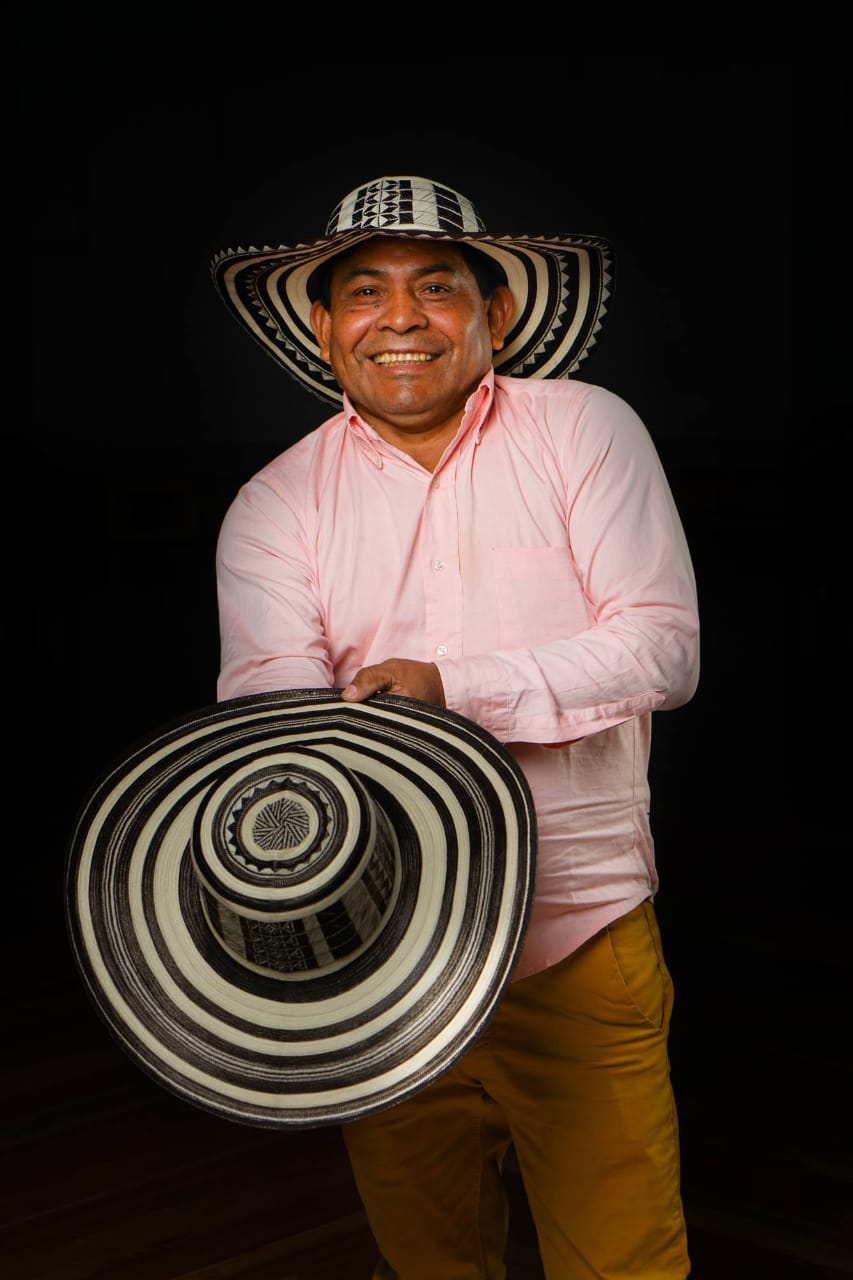
Reinel Antonio Mendoza Montalvo of Finatur.
Indigenous Migrant Artists
Amalia Palomino (Quechua), Retablos Palomino y Jimenez, from Peru, residing in Massachusetts. Amalia and her family are known for making retablos, or elaborate wooden boxes which contain colorful religious, historical, or everyday scenes. The techniques she uses to make retablos have been passed down in her family for generations. Artist website.
Isaya Oleporuo (Maasai), The Warriors Organization, from Eluai, Tanzania, residing in Ohio. In order to support the Indigenous peoples of Tanzania, Isaya founded The Warriors Organization, which includes the Maasai Women’s Jewelry Project. This project allows Maasai women to support themselves through jewelry sales. Artist website.
Bernard Domingo (Shona), Domingo’s Wire Craft, from Zimbabwe, currently residing in New York. Bernard began working with wire at the age of six, when he started making toys for himself. Since teaching other children how to make toys, Bernard’s beaded wire crafts have grown into a business he uses to support himself and his family back in Zimbabwe. Artist Facebook Page
Inca Son, from Cambridge, MA. Inca Son, made up of Omar Clavijo (Aymara) from La Paz, Bolivia, René Quisbert (Aymara) from La Paz, Bolivia, and Santos Alva (Inca) from Ascope, Peru, makes it their mission to celebrate and instill an appreciation for Andean culture through music and dance. The group is characterized by pan-flutes and the Andean ten-stringed guitar, the charango. Artist website
Solomon Murungu (Shona), Zambuku Projects Unlimited, from Zimbabwe, currently residing in Massachusetts. As a student of the mbira, an instrument that is central to traditional music in Zimbabwe, Murungu has traveled extensively in order to promote cross-cultural exploration through presentations on mbira music and Shona culture. “Zambuko" is a Shona-language word meaning "bridge."
Finatur (Zenu, Wounann, Wayuu, Arhuaco, and Kamentsa), Colombia, with an organization branch in the U.S. The Finatur Design cooperative is composed of over 200 caña flecha (palm fiber) artists from five Colombian communities: Zenu, Wounann, Wayuu, Arhuaco, and Kamentsa. The artists’ work features three-dimensional accessories such as hats, bags, and jewelry woven from caña flecha and other natural materials that grow on the land where the communities reside. Artist website
Roberto Cachimuel (Quichua), Yarina, from Otavalo, Ecuador, currently living in Massachusetts.
Roberto Cachimuel is one of the founding members of Yarina, a family of musicians from Otavalo, Ecuador, that has received wide acclaim in their home country and abroad. Yarina, meaning “remembrance” in Cachimuel’s native language, Quichua, was formed in 1984 to promote native arts and culture during the formative years of Ecuador’s burgeoning Indigenous political and cultural rights movement. Artist website.
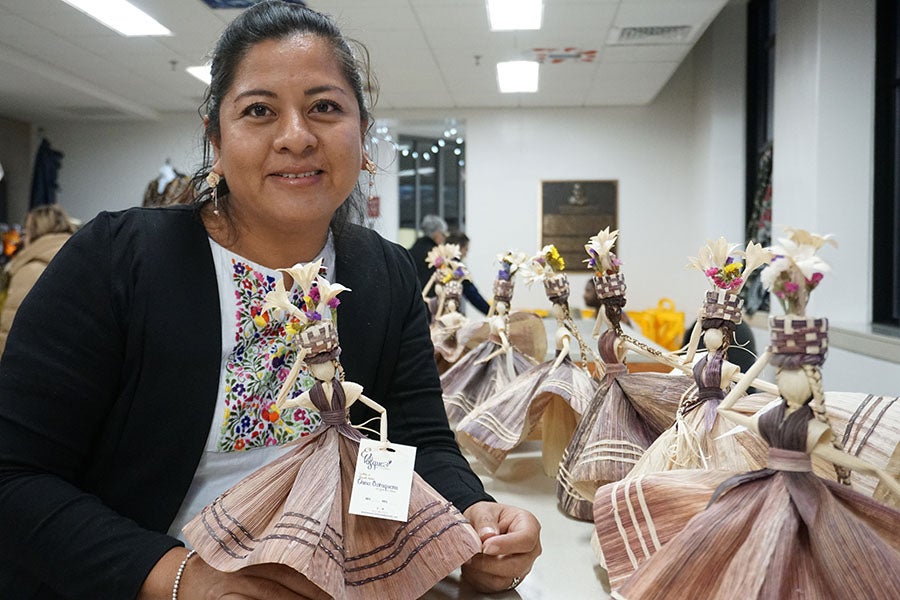
Eva Vasquez Clemente.
Mexico
Eva Vasquez Clemente (Zapotec-Mixtec) from Oaxaca, Mexico. Eva makes exquisitely detailed corn husk dolls that represent traditional women dancers of the renowned annual Guelaguetza Festival. She creates her pieces entirely by hand with organic products and natural colors.
Julio Laja Chichicaxtle (Otomí), Papel Amate Otomí, from San Pablito, Puebla, Mexico. Julio comes from a family which has made papel amate otomí, or Otomi bark paper, for over two hundred years. In order to make papel amate, the bark is harvested, boiled, and washed before being used in embroidery for clothes, tapestries, and more.
Juan Garcia Mendoza (Mixtec), Arte Palma from Oaxaca, Mexico. Hailing from San Pedro Jocotipac, Oaxaca, Juan founded Arte Palma in 2010 and sells baskets, chairs, hats, rugs, and other decorative products that he and other local artists make from native palm. He also runs workshops for young people in order to pass on the craft of weaving palm to future generations. Artist website
Eliseo Ramirez (Zapotec), Khadi Oaxaca, from Oaxaca, Mexico. As one of the founding artists in Khadi Oaxaca, a collective of over 450 local families and artisans, Eliseo weaves intricate designs using sustainable materials such as organic cotton, oak bark, and natural dyes like indigo. Along with the production of his works of art, he leads weaving workshops to share cultural knowledge with his community. Artist website
Roberto Mejía and Patricia García (Nahuatl), Yolopopotli, from Los Reyes LaPaz, Mexico. Roberto Mejía and Patricia García have mastered popotillo design. To describe popotillo art as “painting with straw” does not fully capture the beauty of their work, rather, it’s helpful to picture Patricia with bundles of vibrant colors of straw, using one hand to pin a piece of straw in place, and the other to bend the straw, lining it up perfectly alongside the previous straw to build whichever dreamscape she’s envisioning. The work is meticulous, and performed at a wide range of scales, from entire landscapes woven into an image no bigger than a thumb, to grander, framed pieces to hang on walls. Artists Facebook page.
Nigeria
Akinwale Akinsola, Human Face Trading & Projects, from Pretoria, South Africa. Akinwale is a Nigerian artist who creates elaborately carved wooden pieces, including figurines and chess sets. Artist Facebook Page
India
Himalayan Naari, from the Indian Himalayas. Naari in Hindi means, “a woman of incredible strength, resolve, and grace.” This term is apt for the collective of 100 artisans who create intricate woolen crafts from traditional knitting and weaving practices. The knitwear the collective makes is influenced by aipan, a traditional folk art made by women in the Kumaoun region of the Himalayas. Artist website
Top photo L-R: Deborah Spears Moorehead, Bernard Domingo, and Amalia Palomino.
